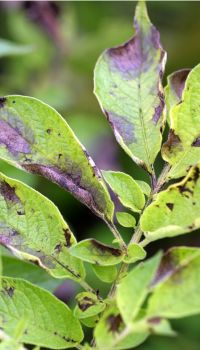Introduction
Late blight of potato and tomato caused by Phytophthora infestans is a devastating disease worldwide and led to the Irish potato famine in 1845. Under favorable weather conditions, tomato and potato crops can be destroyed within days if left untreated. Yield losses caused by late blight and the cost of control measures have been estimated to exceed $6.7 billion annually and the disease is a major threat to food security worldwide. Knowing where the disease is present can help improve the efficacy of fungicide treatments. Ristaino, J. B. “USABlight: A National Project on Tomato & Potato Late Blight.” NC State, 2009, usablight.org/.
Communication Protocols for Suspected Outbreaks
Confirmed late blight detections in Michigan are typically reported through an MSU Extension news article, shared through the Michigan Potato Industry Commission (MPIC) E-newsletter mailing list, and reported to the USABlight current outbreaks database.
If you'd like to receive the MPIC e-newsletter, sign up here.
Additional communication information:
- Plant and Pest Diagnostics Submit Samples – For submission of diseased samples, visit the MSU Diagnostic clinic website, which includes contact information, services, fees, and sample submission forms and instructions.
- *Both MSU Plant & Pest Diagnostics and MSU Potato & Sugar Beet Pathology can process diagnostic late blight samples, including Phytophthora species confirmation. MSU Potato & Sugar Beet Pathology can also provide genotype information.
- USA blight – National platform with information about current late blight outbreaks, pathogen genotypes, and management recommendations.
- UW-Madison Vegetable Disease & Insect Forecasting Network – Provides estimations of current late blight risk using remote, gridded weather data in the Upper Midwest, including Michigan.
- *Coming soon* MSU Enviroweather late blight predictive model tools (in development, for release this summer 2025) – Will provide seasonal and weekly predictions for potato volunteer survival and current late blight risk through a local network of weather stations maintained by MSU Enviroweather (https://enviroweather.msu.edu/).
Disease Management Guidelines
 Late blight of potato, caused by the water mold Phytophthora infestans, has the potential to be a very destructive disease of potato in Michigan. The pathogen favors wet weather with moderate temperatures (60 to 80 °F), high humidity and frequent rainfall. Under such conditions, the disease can spread extremely rapidly and has the potential to completely defoliate fields within 3 weeks of the first visible infections if no control measures are taken. In addition to attacking foliage, P. infestans can infect tubers at any stage of development before or after harvest. Soft rot of tubers often occurs in storage following tuber infections. Douches, David. “Michigan Potato Diseases: Late Blight.” Potato Outreach Program, 10 Nov. 2015, www.canr.msu.edu/resources/michigan_potato_diseases_late_blight_e2945.
Late blight of potato, caused by the water mold Phytophthora infestans, has the potential to be a very destructive disease of potato in Michigan. The pathogen favors wet weather with moderate temperatures (60 to 80 °F), high humidity and frequent rainfall. Under such conditions, the disease can spread extremely rapidly and has the potential to completely defoliate fields within 3 weeks of the first visible infections if no control measures are taken. In addition to attacking foliage, P. infestans can infect tubers at any stage of development before or after harvest. Soft rot of tubers often occurs in storage following tuber infections. Douches, David. “Michigan Potato Diseases: Late Blight.” Potato Outreach Program, 10 Nov. 2015, www.canr.msu.edu/resources/michigan_potato_diseases_late_blight_e2945.
Additional disease management information:
- MSU Extension Potato Late blight Disease bulletin – Includes monitoring and control practices for late blight.
- Pre- and Early Season Control Measures for Late Blight – Mid-Michigan Agronomy research article.
- Potato and Sugar Beet Pathology – Additional information about potato diseases, helpful resources, research reports, and Extension updates.
- Long-season labels and late blight updates impacting Michigan potato production – Article highlighting chlorothalonil label updates impacting late blight management. July 23, 2025.
Fungicide Recommendations
The late blight pathogen causes quick plant death and can be identified by large spreading brown stem lesions, velvety white growth on plant surfaces, and large brown leathery spots on green fruits. It is favored by prolonged cool and damp conditions. The pathogen overwinters on plant residue, including volunteer potatoes and potato cull piles. When it is reported in your region, begin weekly preventive sprays with chlorothalonil and mancozeb for as long as favorable conditions persist. Pay attention to which pathogen strain is identified. If infections start in a field, the strain US-23 is sensitive to mefenoxam (Ridomil). Phillips, Ben. “Potato - Horticulture.” Midwest Vegetable Potato Production Guide, Oct. 2020, mwveguide.org/uploads/pdfs/Potato_2024-12-03-155601_aasc.pdf.
Additional fungicide recommendation information:
- MSU Extension Potato Late blight Disease bulletin – Chemical control pgs. 6-8
- Midwest vegetable potato production guide – Late Blight of Potatoes/Tomatoes - Phytophthora Oomycete pg. 5
- 24(c) Special Local Needs Pesticide Labels – Current special local needs labels registered for use in Michigan. For valid use, the labels in the provided links must have a valid, active expiration date. For additional information, contact Kevin Kern, MDARD pesticide registration specialist, at kernk@michigan.gov or 989-239-7637.
